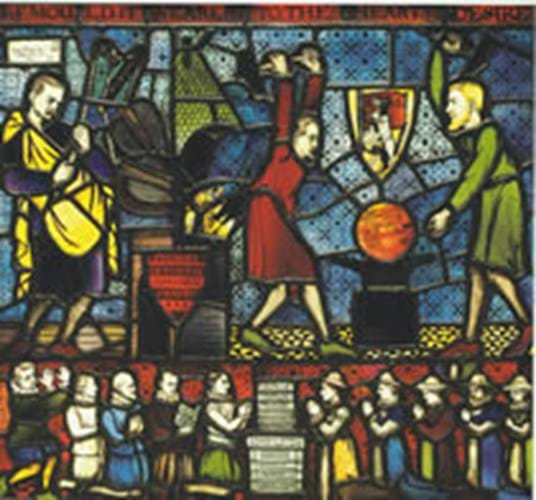
Designed by George Bernard Shaw in 1910 the window is a witty realisation of the Fabian Society's aim to forge a new world order. It shows Sidney Webb and Shaw hammering the globe into shape as the society's secretary, Edward Pease, operates the forge bellows. At the top is the legend Remould it to the Heart's Desire, and on the shield beneath the forge, the motto Pray Devoutly, Hammer Stoutly. Over the globe is seen the Fabian coat of arms of a wolf in sheep's clothing.
The lower panel is centred by a stack of books that include works by both Webb and Shaw and kneeling to either side, as if in homage, are members of the Executive Committee - men to the left, women to the right. Far left is H.G. Wells, and at far right, the artist Caroline Townshend, who actually made the window. The garb affected by the participants was inspired by Edward Pease's fondness for the Tudor period and like the design as a whole, parodies earlier church art.
The presence of Wells, cocking a snook, in the corner is no accident. Wells, who wanted a revolutionary re-organization of the Fabian Society and a disbandment of the "Old Gang" of committee members, was soundly defeated in a 1906 meeting at which Shaw made fun of him from the platform and reduced his audience to fits of laughter.
Wells resigned from the Fabians in 1908 and in 1910 (the same year that Shaw designed the window) presented some satirical portraits of Fabians in The New Machiavelli. His grievance resurfaced posthumously at the time of Shaw's death in 1950, when a rather sour obituary by Wells (who had died in 1946) was published.
Shaw never actually collected the window and it stayed in Caroline Townshend's workshops until 1947, when her niece presented it to the Beatrice Webb House at Holmbury St. Mary. It remained there until 1978, when it mysteriously disappeared.
It was subsequently traced to America, where it had been acquired at a Californian importer-wholesaler's auction. Beatrice Webb House reached an accommodation with the new owner that it would be put back up for sale and the proceeds divided between them. In 1980, it was duly offered by Ledbetters of Phoenix, Arizona, and was once again knocked down to the man who had bought in good faith at that California sale. He was Sotheby's vendor on this occasion.
Quaritch, who seemed to have had little competition at Sotheby's, bought it for stock at the low estimate of £19,000, but are hopeful that it will in due course find itself back in the most appropriate of homes.
Ian McKay




